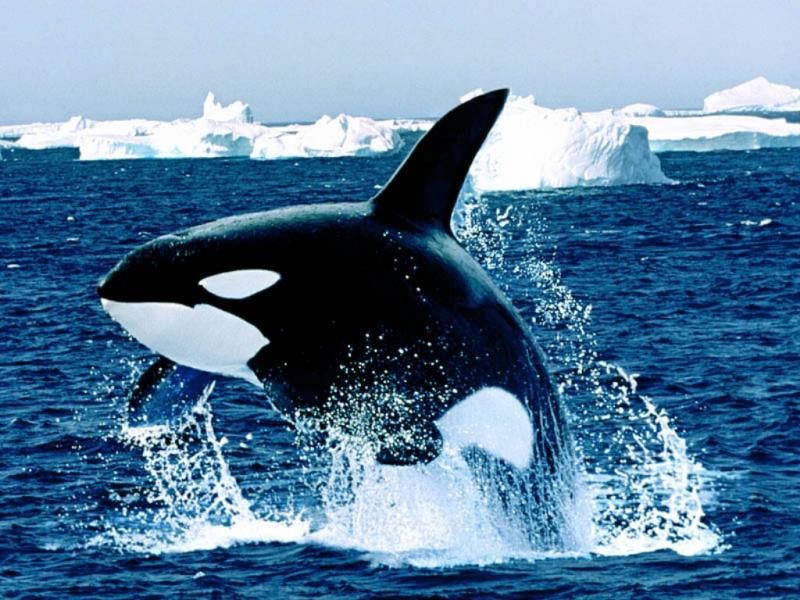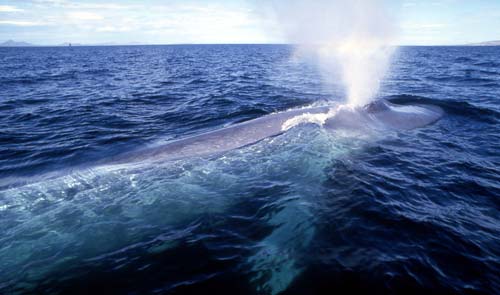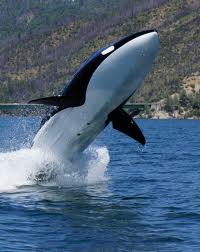POKING THROUGH THE ICY HOLES
HI THERE, COME ON IN!
WHALE
What a creature like a boat
That can even float
A monster of a pet
But likes to be your pet.

Whales
Newfoundland is a place where people go to watch the whales for there are 22 species of them that can be seen in this area. The name whale can include the marine mammals of many different kinds. The blue whale can be 98 feet long and weigh 180 tons. It is the largest animal known on earth. Whales live in all the earth’s oceans and there are millions of them.
Some whales have a filter like structure to filter their plankton or seaweed food into the mouth and some have teeth like the fish.
Whales are mammals and like you and I they breathe air and not like the fish. They are warm-blooded and have a four-chamber heart and they also grow hair and not like the fish that has scales. They give birth to their young and nurse their babies with mammary glands. The milk is very rich and quite thick and the mother squirts it into the baby’s mouth. The baby has a very strong bond to its mother and they stay together for about a year.
{{{ Whales breathe via blowholes; baleen whales have two and toothed whales have one. These are located on the top of the head, allowing the animal to remain almost completely submerged while breathing. Breathing involves expelling excess water from the blowhole, forming an upward spout, followed by inhaling air into the lungs. Spout shapes differ among species and can help with identification.}}}
The whale has fins but the tail has two flukes that make it move vertical and not like the fish that moves horizontal the baby is called a calf. The mother is a cow and the daddy is a bull.
They have ears but they receive the sound through the throat under water. They like to come up out of the water and be exposed to the air. They rest but are never completely asleep so they don’t drown because they breathe like human. Some kinds of whales make a clicking sound while others have a song they sing and can be heard miles away. There are whales that are uniquely tamed and give a lot of entertainment but you have to be alert for they can be very dangerous, as also those whales that have teeth eat other fish and squid and other whales.
Blue Whale blowing air

VARIETIES OF SEA LIFE.
AFTER a restless, sea-sick night, we are glad to remain in our berths the second day of our voyage. This terrible sea-sickness is much like the sickening sensation produced by swinging too long. In case of the swing, however, one may get upon firm ground and soon recover, but in this case the "bounding billows" do not cease their motion, our swing does not stop.
While lying in our berths, we witness a snow-squall through the window. This leaves two inches of snow for the sailors to clear from the deck; and an interesting pastime they find it, we judge, by their good cheer at their work.
We are able to be up today only long enough to go to the upper saloon and learn the result of the noon observation. We have made two hundred and eighty-eight miles since yesterday noon. We are now five hundred and fifty-six miles from New York City, and about one hundred miles southeast of Nova Scotia.
On the morning of the third day, we find the sea more calm, and having enjoyed a good night's rest, we are able to spend quite a portion of the day in the upper saloon and upon deck. As the clouds lift, we see a steamer and two sailing vessels in the distance. It seems good to see anything to break the monotony of life on shipboard. I presume it was a sense of this monotony that caused a wag to write these words on the cabin window:
"VARIETY OF SEA LIFE. Sometimes we ship a sea; sometimes we see a ship."
This desire to see something leads to all manner of speculations. As we have ample time to think of all the sea-monsters of which we have ever read, it is not strange that some of our passengers are keeping a sharp lookout in every direction for whales.
Inexperienced passengers do not always understand that whales, like some kinds of birds, migrate. We are told that it is the wrong season of the year to look for whales in this part of the ocean.
While we are talking of the whale, an objection is raised to the Bible story that Jonah was swallowed by one. There are some who claim that a whale's throat is not large enough to swallow a man. I once heard a lecture on whale-fishing. In reply to the question, "What is the size of a whale's throat?" the speaker said, "That depends upon where you are." So it does. Mr. Chambers, in his Encyclopedia, Vol. X, p. 151, says of the Greenland, or bone whale, "The gullet is not more than one inch and a half in diameter, even in a large whale. "Of the South-Sea, or sperm whale, he says, "The head is enormously large, forming about one-half of the entire bulk of the animal, and occupying more than one-third of the entire length. The mouth is very large and wide, and the throat, unlike that of the Greenland whale, is very wide, sufficiently so to admit the body of a man." Vol. II, pp. 450, 480.
But while thus musing and talking of the monsters of the deep, another observation has been made and reported. The distance made since yesterday is two hundred and ninety miles. We are now eight hundred and forty-six miles from New York, and are directly south of Newfoundland. We are nearing the Newfoundland Banks; and as this is one of the dangerous places of the Atlantic Ocean, we pray God to give us a safe passage over these banks.
J. N. L.

Wholphin, a cross between a whale and a dolphin

A CURIOSITY.
THE following letter from Rye, New Hampshire, under date of May 19, 1881, will, we think, be of interest to the children. It was originally published in the Haverhill Bulletin.
My Dear Nephew: I must tell you what a curiosity we have on Rye Beach. You know we have had a long, hard storm this week. Well, Monday night the sea was very rough, and the great waves washed on to the beach a whale sixty-seven feet long and fifteen feet wide. His mouth is large enough for a good many boys to stand in, and his tongue is as large as you are, and three times as long as you are tall.
He is ribbed on the under side something like a seamed stocking, black and white, in stripes about six inches wide. His back is nearly black.
One hundred and seventy-five teams, loaded with people, have passed our house today on the way to pay his whale ship a visit; and more than that number passed yesterday, besides hundreds of people from Portsmouth, who did not take this road.
A four-horse team, from Exeter, full of boys, visited him today, and two young men who had driven twenty-two miles to pay their respects to him, called here for grain for their horses.
I believe a steam tug is to-tow him away toward the place where the Sagamore House formerly stood, and he is to be cut up for dressing the land.
More than a hundred years ago a whale was washed ashore on Wallis Sands, but no one is now living who saw it, and probably nothing like it will occur again for a great many years.
I wish you could see him, as you cannot realize his size from my description.
A WHALING VOYAGE.
PERHAPS the family would like to learn something about whales and the manner in which they are caught. The writer has been engaged in this perilous occupation for a number of years past, and can tell something about these monsters of the deep. Many who live away from the ocean get imperfect ideas of these things. If it were not so, we should not have so many green hands when the ship leaves port. As I wish to give you a correct idea of whaling, we must commence with the vessel. These ships are like others, except in the apparatus used. On the deck are two large pots, or kettles, set in brick.
The ship has several boats capable of carrying from fifteen to forty men, according to the size of the boat.
As soon as the ship is clear from the land, the search for whales is begun. The men go aloft, and stand upon the top gallant cross-bars, which is nearly as high as they can go on the masts, and from this height they look in all directions. Generally there are five men aloft at the same time, and these are relieved by others every two hours.
This watch is kept up constantly every day during the entire voyage. The deck of a whale ship presents a busy scene the first few weeks from home.
The boats are to be put in readiness, which is no small matter. These boats are twenty-eight feet long. Both ends are very sharp, enabling them to be moved backward or forward with ease. There are five seats, and each boat is managed by six men, five pulling or rowing, and one steering with an oar twenty feet long. Each man has his place in the boat, and each his own particular duty. The safety of the crew depends upon prompt obedience to the commands of the officer. Many a poor fellow has found a watery grave by the neglect of duty or the carelessness of one of the crew. Between the last two seats is a tub of tow line two hundred fathoms long. On one side of the boat, at the for ward end, are three or four harpoons; on the other are three lances. The harpoon is a rod of one-half inch iron, having on one end a socket in which to insert the sharpened end of a pole six feet long; the other end has a head about seven inches long, fastened at the extreme end of the rod by means of a rivet, thus allowing the head to turn crosswise of the rod, or shank. This head is ground very sharp, and turned so as to have it in line with the shank; and it is kept in its place by a small wooden pin. When it is driven into the whale, the wooden pin breaks, and allows the head to turn crosswise as soon as there is any strain upon the line that is attached to it, so the harpoon cannot be very easily withdrawn.
The lance is placed upon the whale in the same manner, but the shank is much longer, often measuring six feet. The head is diamond shaped, and is five inches long, ground very sharp all' around its edge. This is the common instrument for killing. We have still another that is used very successfully. It isthe bomb lance. This is about fifteen inches long and one and a quarter inches in diameter, and has a sharp point. It is a tube filled with powder. It is discharged from a gun, and explodes after entering the whale.
The boat is also provided with a long, narrow keg, wherein is stored some sea biscuit, a compass, and a tinder box and flint, as matches would soon become useless. A large knife is placed at each end of the boat, and also a hatchet. The boat carries a mast and sails ; this mast can be raised, and the sails set, in less than one minute. A keg of fresh water, a bucket to bail out with, and a paddle for each man, and the boat is ready for the first whale that shows itself. These boats are hung upon cranes at the side of the ship, and can be lowered into the water very quickly. By the time one reaches the water, each man is in his place, and the boat drops astern.
There are several different kinds of whales, the most valuable being the sperm whale, and right, or Arctic, whale. The latter grows to a great size, and yields as high as two hundred barrels of oil and over a thousand pounds of bone. This bone, strange as it may seem, all comes from the inside of the mouth. The sperm whale grows very large, and yields as high as one hundred and forty barrels of oil, but it has no bone. There are also three other kinds,-the Humpback, the Finback, and the Sulphur Bottom; but the two latter are seldom captured, partly because of the inferior quality of the oil, but more particularly on account of the rapidity with which they swim. The Sulphur Bottom sounds, or goes down, so deep that there is great danger of drawing the boat after it,
so that this whale is not often troubled. The Humpback is quite 'extensively taken, although the bone is almost useless, and the oil of inferior quality.
I have shown you what a whale boat is, and think you all understand it. Now let us return to the ship. It often happens that whales are met with when only a few days from home. One of the men at the mast head, as his eyes wander over the vast surface of water spread out before him, sees in the distance, perhaps three or four miles away, a little cloud of spray, like a puff of steam. In an instant his eye is riveted, to the spot, and in about thirty seconds he sees it again. No, he is not mistaken:---it is a whale; and with the next breath, he shouts, "There blows." The officer on the deck shouts, "'Where-a-way I" The man at the mast head gives the direction of the whale from the ship, and each time he sees the whale spout, the cry, "There blows," is heard from aloft. The Captain now goes aloft, and gives directions as to the course to steer. All seems to be confusion on deck. The green hands are watching with eager eyes for something, they hardly know what; but those who understand the business are looking to see if the boats are all right.
When the Captain thinks the ship is near enough, he orders the boats to be lowered and manned;
and if there is any wind, the mast is raised, the sail set, and the boat is soon speeding away over the rough sea, its course being guided by signals from the ship. The poor whale, unconscious of its danger, is quietly feeding. As the boat nears the victim, the paddles are used in place of the oars, so as to make as little noise as piissible. The boat header tells the boat steerer to stand up. The long tow line is already attached to the harpoon ; for a moment it is poised in the air, when the officer says, " Give it to him," and the harpoon is buried in the side of the whale. It hardly knows what has happened to it, and for a moment shivers, and then plunges headlong down into the dark waters. The boat is now fast to the whale, and the line runs out so rapidly that it is necessary to have it soaked with water to prevent its taking fire.. All this time the boat is rushing through the water with great speed, but all at once it stops-the whale is coming up. The direction of the line shows where the whale is ; and as soon as he starts to come to the surface, the line slackens, and it is immediately drawn into the boat. When the whale makes his appearance, the boat is so close upon it that it is lanced and sometimes killed before it can go down again. At other times it takes all day and often all night to kill it,
The next work is to get it along-side of the ship.
The ship follows the whale as near as it can; and when the whale is dead, she sails along-side of it, and firmly secures it by the fluke or tail.
GEO. F. KING.